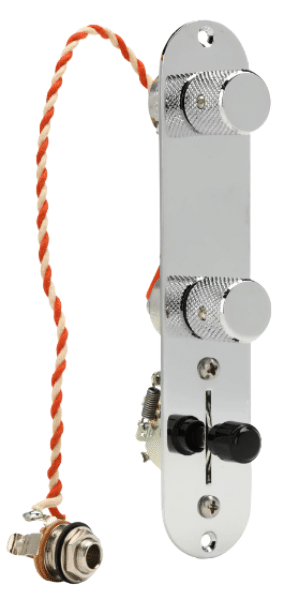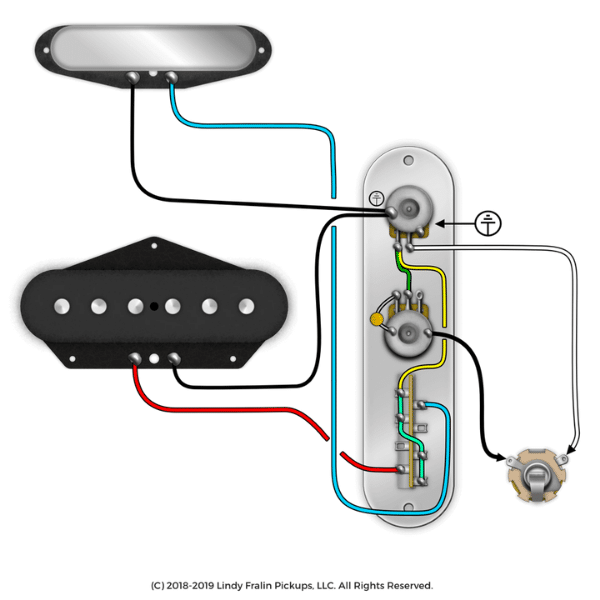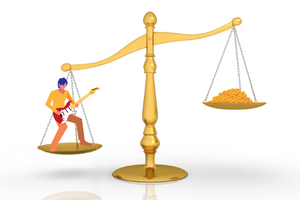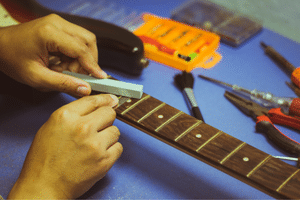
Are you tired of stretching your fingers to do volume swells and tone (wah-wah) effects on your Telecaster? The solution is simple! In this “how to reverse telecaster control plate wiring” article, I will reveal all the steps necessary to rewire your old Tele control plate or build a new one from scratch.
Keep on reading to get yourself up and running in no time!
You can use the table of contents below to take you to the area that interests you. Click on the little box to open it and then click on the section of the article you want to read, or you can read from start to finish if you want the full reverse Tele wiring experience!
Click here to go directly to the rewiring video if you are in a hurry.
What Is A Reverse Telecaster Control Plate?
If you know about Teles, you can see from the image above that a “reversed” plate flips the controls so that the volume and tone are on top and the three-way pickup selector switch is below.
However, in reality, it’s not that simple. If you unscrew the Tele control plate, flip it over, and reinstall it upside down, you will be left with the following problems.
- The Tone control will now be on top
- Below the Tone knob will be the Volume control
- The pickup selector switch is also upside down & counter-intuitive (bridge-middle-neck)
Therefore, you will have to rewire the control plate or buy yourself a pre-wired one to make things right again. You won’t be able to simply switch the position of the Volume and Tone pots and flip the selector switch without doing some rewiring (if that’s what you are thinking).
So, Why Reverse The Control Plate?
Reversing the Tele control plate gives you better access to the volume and tone controls. So, to “Turn” or “Switch.” That Is The Question!
If you like to do volume swells on your Tele, having the volume knob closer to your fingers will make things easier. Some players also do wah-wah effects with the tone knob.
On the other hand, if you think volume pedals are better for bringing notes in and out of the mix and you like to switch pickups a lot while you play, you’ll be better off leaving well enough alone and sticking with the traditional Tele control plate wiring.
Who Started The Reverse Telecaster Control Plate Idea?
It’s hard to say precisely who was the first player to reverse-wire a Tele control plate, but it’s a good bet that it was guitar great Bill Kirchen.

Who Is Bill Kirchen?
Bill Kirchen is an American Tele player, best known for playing from 1967 to the mid-70s in the country-rock band “Commander Cody and His Lost Planet Airmen.”
He has also worked with such greats as Elvis Costello and Gene Vincent.
Bill’s signature sound includes elements of country, rockabilly, western swing, boogie-woogie, and blues. His music has often catered to the American truck driver, as noted on his albums “Tied to the Wheel,” Dieselbilly Road Trip,” and “King of Dieselbilly.”
Here’s a video with Dan Erlewine “Talking Tele” with Bill Kirchen. Bill shows off his reverse wiring Tele and explains why he likes it, backing it up with a few great demonstrations. Enjoy!
Changing Your Tele Over To Reverse Wiring
The first thing you need to consider is your best option for making the changeover.
If you’re handy with a soldering iron, you can make your own reverse Tele control plate or re-wire your old one. I recommend starting from scratch and keeping your old one in case you want to switch back or sell the guitar.
You can skip the hassle altogether and buy yourself a telecaster pre wired control plate, ready to drop in your guitar, but where’s the fun in that? ?

Control Plate Assembly Checklist
Here is the assembly equipment you will need. You can either rewire your old Tele control plate or build a new one from scratch. If you make a new one, here is the parts list.
Equipment
- Soldering iron
- Solder (lead-free)
- Wire stripper
- Wire cutter
- Soldering aid tool (optional)
Parts
- Telecaster Control Plate With Screws
- Two 250K-Ohm Pots (Volume & Tone)
- Two Telecaster Control Knobs
- Three-Way Pickup Selector Switch
- 0.047 uF Disc Capacitor
- Input Jack Socket
- Cloth Wire (Black & White – Approximately 2 Feet)
Keep On Reading To Learn More
How To Wire A Reverse Tele Control Plate
In addition to the assembly equipment and parts listed above, here is the video and wiring schematic you need to create your own reverse Telecaster control plate.
This video from Six String Supplies is excellent and takes you through the entire wiring procedure, step by step.
This diagram from Lindy Fralin Pickups shows you the correct wiring for a reverse Tele control plate. They make some of the best guitar pickups on the planet! I love using their products in the guitars I build.

How About A Reverse Tele With A 4-Way Switch?

Some Tele players like a “4-way” pickup wiring configuration. This allows each pickup to be selected separately and both pickups to be used at once while wired either in parallel or in series.
This wiring configuration can be built two ways
- Using a special 4-way (blade) pickup selector switch
- With a standard 3-way blade switch and a toggle switch (seen at the red arrow in the photo) to put the two pickups in parallel or series
Wiring both pickups in series ramps up the audio output, making them sound like a hot middle pickup, great for playing a crunchy rhythm or mildly overdriven lead.
You can use a 4-way configuration with either standard or reverse Tele control plate wiring. If you’re building the control plate, getting a 4-way pickup selector switch (like an Oak Grigsby) is easier because it will save you the trouble of drilling a hole to install the toggle switch between the volume and tone controls.

Advantages Of A Reversed Plate
- Easier to do volume swells
- Much easier to do tone swells for wah-wah pedal-like effects

Disadvantages Of Reversing It
- Pickup selector switch is farther away
- Can lower the resale value of expensive or vintage Teles

Careful Modifying Your Guitar!
Before you make any modifications to your guitar, be sure that you are making a wise decision.
If you have an expensive guitar, like a limited edition or a vintage model, making any modifications can significantly lower the resale value of the instrument!
Something as little as unsoldering and resoldering a connection, replacing a part, or cutting into the wood where it cannot be seen when the guitar is reassembled can affect its value.
Even if you keep all the original parts, collectors may penalize you for the changes you make and offer you less money.
My Reverse Telecaster Control Plate Guitar
I put together a Tele in 2009 with some unique specs, including a Fender Stratocaster neck, a Warmoth Telecaster body, and a pre-wired Callaham reversed control plate. It’s sort of like a “Tele-Strat.”
Here on the specs on the control plate:
- Callaham Reverse-Wired T Model Stainless Steel Control Plate Assembly with cryogenically treated CTS 250k solid shaft pots, 0.047 mfd orange drop capacitor, CRL Switchcraft switch, & vintage style cloth-covered wire. Old-style round black switch tip, Callaham heavy knurled old-style flat-top knobs (replaced with Stew-Mac black knobs).
Here’s what I used to build the rest of the guitar if you’re curious:
- Fender American Standard Deluxe Modern C-shape maple neck with satin polyurethane finish
- Maple fingerboard with abalone dot position inlays and 22 medium jumbo frets
- Fender Schaller Locking Tuners
- Warmoth one piece Swap Ash body with glossy clear coat finish
- Warmoth Black Pearl Telecaster Pickguard
- Fender samarium cobalt neck & bridge noiseless Telecaster pickups
- Glendale vintage Blackguard “single-cut” cold rolled steel chrome plated bridge
- Wilkinson adjustable compensted brass saddles
- Electrosocket input jack

So, How Does The Guitar Play And Sound?
The guitar plays like a Strat with the fast Fender neck but sounds more like a Tele with the swamp ash body. I love being able to do volume swells with country licks since the volume knob is right where I want it! The StewMac knobs are small with just the right amount of knurl to make them easy to turn quickly.
The samarium cobalt noiseless Tele pickups blend really well with the swamp ash body and cold rolled steel bridge to give it a hard-edge vintage sound, mellowed a little by the brass saddles.
These Wilkinson compensated saddles, together with the locking tuners, work great. The intonation is always “spot on,” and the guitar never goes out of tune, no matter how far I bend the strings.

Is Reversing The Tele Plate Legit?
Although there are many things to consider before making modifications to any guitar, if you love the sound of a Tele but prefer playing a Strat because the volume knob is conveniently available, this may be the modification for you.
Unfortunately, it’s challenging to find a reverse control plate Tele in a music store to try out and see if you like it.
If you don’t already have a Tele, you can always buy a low-cost model and try the modification. It’s definitely food for thought!
If you’re in the market for a ridiculously excellent-sounding Tele, check out my article on the Player Plus Nashville Telecaster Review: The Best Tele Ever!

Are You Qualified To Make Guitar Adjustments Or Modifications?
It’s great to work on your guitars, especially if you have a lot of them, but you should always be aware of your limitations.
Adjusting things like an electric guitar’s string height (action) or pickup height can be straightforward. Still, some adjustments require the proper training and experience, like adjusting a guitar’s truss rod.
When you doubt your ability to adjust, repair, or modify your guitar, it’s always best to bring it to a competent guitar technician or luthier (guitar designer & builder). You can permanently damage your guitar, and it might never play and sound right again!
Making modifications to your guitar can void its manufacturer’s warranty and cause permanent damage to the instrument. Certain modifications are irreversible, so you may be stuck with them, even if you desperately want to restore the guitar to its original condition!
I learned that the hard way over the years until I did a three-year apprenticeship in a guitar repair shop. Now I have my own home workshop with the proper training and equipment to safely maintain and repair all my instruments.
Remember: “When In Doubt, Send It Out!”

Frequently Asked Questions
Here are some of the questions I get asked about rewiring Telecasters.
If your question does not appear here, please put it in the comments, and I will get right back to you with an answer.
Who Uses A Tele Reverse Control Plate?
The Tele player that popularized it was Bill Kirchen, whose story is outlined above. There are not many other famous Tele players that swear by this modification. If you know of others, please leave me a comment, and I will add that info to this section.
Can You Buy Pre-Wired Reverse Tele Control Plates?
Yes. You can buy them from online guitar stores and companies that hand-wind boutique pickups or make custom Tele hardware, like Lindy Fralin or Callaham.
Are Telecasters Wired In Series Or Parallel?
When both Tele pickups are selected together using the middle position on the selector switch, they are usually wired in Parallel. Some Teles may be set up to give you the option of selecting both pickups in a parallel or series configuration by using a 4-way switching system.
What Does A 4-Way Switch Do On A Telecaster?
A 4-way switching system allows you to use both pickups together in either a parallel or series wiring configuration. This is most commonly done by replacing the 3-way blade switch with a 4-way version or adding a toggle switch to the control plate of the guitar.
Wiring both pickups in series increases their audio output, making them sound like a hot middle pickup, great for playing a beefy or crunchy rhythm and a mildly overdriven lead.
What To Do If Your Pickups Are Out Of Phase
If your pickups are out of phase, the polarity of one of them needs to be reversed. You can do this by switching the wires so that the “positive” side of that pickup is connected to the ground and the “negative” side is connected to the positive terminal on the pickup selector switch.
It doesn’t make a difference which pickup you choose to switch the wires.
Two Tele pickups that are out of phase will sound soft and “low-fi” because the audio signal from each pickup is “canceling out” the signal from the other.

Final Thoughts
A reverse Telecaster control plate puts the guitar’s volume and tone knobs closer to the player’s picking hand, making it easier to operate them while playing a song.
This is particularly useful for players that do frequent volume swells and wah-wah effects and eliminates the need for using these types of pedals.
To make the reverse modification, you can rewire the existing control plate, create a new control plate from scratch, or buy a pre-wired reverse control plate.
Making a 4-way reverse Tele control plate will allow you to use the two pickups wired together parallel or in series.
If you change pickups more than you fiddle with the volume and tone knobs while you play, this is probably not the modification for you.

Always think twice about modifying high-end and vintage Teles, which can lower their resale value considerably.

Tell Me What You Think
Please leave a comment below if you enjoyed this article, have any questions about reverse Telecaster control plate wiring, or want to give your point of view. I will be happy to help you.
- Were you aware of reverse control plate wiring?
- Do you own a Tele with reverse wiring? Do you prefer it to the standard wiring? Why?
- After reading this article, are you thinking of rewiring your Tele?



Hi, Frank.
Viewing this type of article is something that is new to me. It is very informative. The topic, I believe has to do with the positioning of the Volume Control, Tone Knob, and the Pickup Selector Switch on the guitar. I did a little research and some people said they just play it without switching pickups. I realize you have to be careful when reversing the control, so as not to damage the wiring. One quick question…I would like to know when you reverse the Control plate is it for comfort or performance?
Hi, Tricia
Thank You for your comments!
Yes, a reverse Telecaster control plate configuration is primarily for players that want the volume knob close to their picking fingers, which allows them to perform volume swells easily.
You either have to rewire the control plate, build a new one from scratch, or buy one that is prewired and ready to drop into the guitar.
Therefore, this control configuration is primarily for performance but also for playing comfort.
Frank
Your post shows that nothing is quite as simple as it seems. Your explanation is clear and shows how to find a solution to rewire the control plate, build a new one from scratch, or buy one that is prewired to use in the guitar. I love to hear a good guitar player and wonder how they can make such incredible sound! Kudos to you for making the mechanics of guitar playing easier so you can get such incredible music from your instrument!
Hi, Carolyn
Thank You for your comments!
I have only used the reverse control plate modification on one of my Teles (that I built from scratch), but I really like the improvement in the volume control position. It’s definitely something for guitar players to consider, especially if they have more than one Telecaster.
Frank